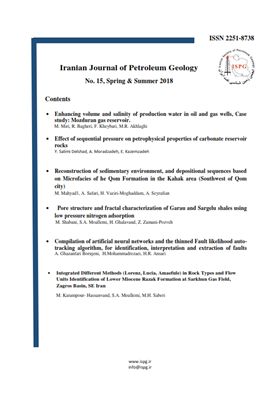Effect of sequential pressure on petrophysical properties of carbonate reservoir rocks
Subject Areas :Ali Moradzadeh 1 , yaser Salimidelshad 2 , Ezatollah Kazemzadeh 3 , abbas Majdi 4
1 - Tehran University
2 - Tehran University
3 -
4 - Tehran University
Keywords: Carbonate reservoir rock Archie classification Cyclic loading Porosity Permeability CT scan images,
Abstract :
Today, oil industry significantly relies on the precise determination of rock reservoir properties, which reduces the costs and risks of production planning. The reservoir rock always is compacted by pressure drop of the reservoir, which rises effective stress, reservoir compaction and alterations of reservoir properties. As these pressure variations can considerably affect petrophysical properties, in this study, several carbonate reservoir rock samples with different fabric and porosity type (according to CT scan and Archie classification analysis) subjected to cyclic and short-term loading from 600 to 6000 psi. Their petrophysical and compressive properties including pore volume, permeability and compressibility were measured using CMS-300 apparatus. Moreover, structural analysis and heterogeneity of core samples were analyzed by CT scan images. By performing this study, it will be possible to identify the value of the hysteresis effect on the reservoir rock samples as a result of increasing and decreasing of the pressure during cyclic loading. The obtained results show that, pore volume and permeability are both decreased due to loading, whereas reduction of the permeability is several times than the pore volume ones. Moreover, this reduction of pore volume is less severe in vuggy porous samples that shows the effect of heterogeneity and porosity type on hysteresis. Also, the results obtained from the behavior of the reservoir rock under various pressure conditions can provide a suitable design for gas injection studies to enhance oil recovery and also natural gas storage.
[1] سعادت، کاظم؛ شريفي گلويك، حميد. "تعيين برخي خواص سنگ شناسي و پتروفيزيکي با استفاده از تکنولوژي سيتي اسکن". اولين کنفرانس و نمايشگاه تخصصي نفت، تهران#
[2] KARACAN, C. O., GRADER, A. S., & HALLECK, P. M. (2001, January 1). 4-D Mapping of Porosity and Investigation of Permeability Changes in Deforming Porous Medium. Society of Petroleum Engineers. doi:10.2118/72379-MS#
[3] FJAER, E., HOLT R. M., HORSRUD P., RAAEN A.M., RISNES R., “Petroleum Related Rock Mechanics”, Elsevier, 1992#
[4] DAIM, F., EYMARD, R., HILHORST, D., MAINGUY, M., & MASSON, R. (2002). A preconditioned conjugate gradient-based algorithm for coupling geomechanical-reservoir simulations. Oil & Gas Science and Technology, 57(5), 515-523.#
[5] HALL, H.N., (1953). Compressibility of reservoir rocks. Petroleum Transactions, Alme, 198, 309-311.#
[6] HARARI, Z., SHU-TEH, W., & SALIH, S. (1995). Pore-compressibility study of Arabian carbonate reservoir rocks. SPE Formation Evaluation, 10(04), 207-214.#
[7] LIU, H. H., RUTQVIST, J., & BERRYMAN, J. G. (2009). On the relationship between stress and elastic strain for porous and fractured rock. International Journal of Rock Mechanics and Mining Sciences, 46(2), 289-296.#
[8] TELKU, T. W., ZHOU, Z., Li, X., & ABASS, H. (2016, June 26). Cyclic Permeability and Porosity Hysteresis in Mudrocks – Experimental Study. American Rock Mechanics Association.#
[9] RANDOLPH, P. L., SOEDER, D. J., & CHOWIAH, P. (1984, January 1). Porosity and Permeability of Tight Sands. Society of Petroleum Engineers. doi:10.2118/12836-MS#
[10] TEKLU, T. W., LI, X., ZHOU, Z., & ABASS, H. (2017, October 1). Experimental Investigation on Permeability and Porosity Hysteresis of Tight Formations. Society of Petroleum Engineers. doi:10.2118/180226-PA#
[11] AL-HARTHY, S. S., DENNIS, J. W., JING, X. D., & MARSDEN, J. R. (1998, January 1). Hysteresis, True-Triaxial Stress-Path and Pore Pressure Effects on Permeability. Society of Petroleum Engineers. doi:10.2118/47269-MS#
[12] HUGHES, J. D. (2014). Drilling deeper. Post carbon institute Mechanics. #
[13] ANDERSON, D. M., NOBAKHT, M., MOGHADDAM, S., & MATTER, L. (2010). Analysis of production data from fractured shale gas wells. In SPE unconventional gas conference. Society of Petroleum Engineers.#
[14] EIA. (2016). "Drilling Productivity Report for Key tight oil and shale gas regions". Retrieved from http://www.eia.gov/.#
[15] EKER, I., KURTOGLU, B., & KAZEMI, H. (2014). Multiphase Rate Transient Analysis in Unconventional Reservoirs: Theory and Applications. In SPE/CSUR Unconventional Resources Conference–Canada. Society of Petroleum Engineers. #
[16] TEKLU, T. W., ZHOU, Z., LI, X., & ABASS, H. (2016). Experimental Investigation on Permeability and Porosity Hysteresis in Low-Permeability Formations. In SPE Low Perm Symposium. Society of Petroleum Engineers. #
[17] SKINNER, J. T., TOVAR, F. D., & SCHECHTER, D. S. (2015, November 18). Computed Tomography for Petrophysical Characterization of Highly Heterogeneous Reservoir Rock. Society of Petroleum Engineers. doi:10.2118/177257-MS#
[18] ADEBAYO, A. R., KANDIL, M. E., OKASHA, T. M., & SANNI, M. L. (2017). Measurements of electrical resistivity, NMR pore size and distribution, and x-ray CT-scan for performance evaluation of CO2 injection in carbonate rocks: A pilot study. International Journal of Greenhouse Gas Control, 63, 1-11.#
[19] CIVAN, F. (2018, April 22). Effect of Stress Shock and Pressurization/Depressurization Hysteresis on Petrophysical Properties of Naturally-Fractured Reservoir Formations. Society of Petroleum Engineers. doi:10.2118/190081-MS#
[20] SHEERANG S. Ch., EDWARD M. B., SOMNATH S., MATTEW D. D., QUINN R. P., TIMOTHY E. Z., ALEX C. W., JEFF A. B., DANIEL W. B., SERGIO A. LEONARDI, and RYAN A. K, (2015). Steady-state stress-dependent permeability measurements of tight oil-bearing. ExxonMobil Upstream Research Company, Petrophysics, 56 (2): Page 116–124.#
[21] HUEVKEL, T., & NOVA, R. (1979). Some hysteresis effects of the behaviour of geologic media. International Journal of Solids and Structures, 15(8), 625-642. #
[22] HOLT, R. M., FLORENCE, O., Li, L., & FJAER, E. (2004). Consequences of Depletion-Induced Stress Changes On Reservoir Compection and Recovery. In Gulf Rocks 2004, the 6th North America Rock Mechanics Symposium (NARMS). American Rock Mechanics Association. #
[23] DUSSEAULT, M. B., & SANTARELLI, F. J., 1989. A Conceptual Model for Massive Solids Production in Poorly-Consolidated Sandstones," Rock at Great Depth, Maury & Fourmantraux (Eds.), Balkema, Rotterdam, 789–797.#
[24] ROEHLoehl, P. O., & CHOQUETTE, P. W. (Eds.). (2012). Carbonate petroleum reservoirs. Springer Science & Business media.#
[25] KARACAN, C. O., GRADER, A. S., & HALLECK, P. M. (2001, January 1). 4-D Mapping of Porosity and Investigation of Permeability Changes in Deforming Porous Medium. Society of Petroleum Engineers. doi:10.2118/72379-MS.#


